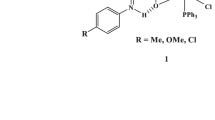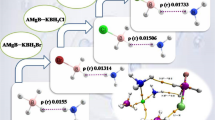Abstract
In the present work, theoretical studies of the reactivity and stability of the NbX5 complexes (X = F, Cl, Br and I) were carried out in the methane C–H bond activation. To study the chemical bonds formation of these complexes, an energy decomposition analysis was performed together with QTAIM calculations. The main results indicated that the interaction and binding energies are higher for NbF5 in relation to the halogen series. The niobium complexes gaps are influenced by the electronegativity of the halogens and the Nb–X bonding lengths. According to the energy diagram, the electrons less connected to the bond are σNb–I; on the other hand, the best electron acceptor is σ*Nb–F. The QTAIM calculations confirmed stronger Nb–X chemical bonds in NbF5 complexes. Regarding the reactivity of the niobium complexes, the overall results indicate better thermodynamic and kinetic conditions for the NbF5 complex.







Similar content being viewed by others
References
Marchetti F, Pampaloni G, Pinzino C (2013) Long-lived radical cation salts obtained by interaction of monocyclic arenes with niobium and tantalum pentahalides at room temperature: EPR and DFT studies. Chem Eur J 19:13962–13969
So SP (1973) Normal coordinate analysis and thermodynamic functions of niobium and tantalum pentahalides. J Mol Struct 16:311–320
Waters T, Wedd AG, Ziolek M, Nowak I (2003) Niobium and tantalum. In: McCleverty JA, Meyer TJ (eds) Comprehensive coordination chemistry II, vol 4. Elsevier, Oxford, pp 242–312
Constantino MG, Júnior VL, Invernize PR, da Silva Filho LC, da Silva GVJ (2007) Opening of epoxide rings catalyzed by niobium pentachloride. Synth Commun 37:3529–3539
Yoshizawa K, Shiota Y, Yamabe T (1998) Methane–methanol conversion by MnO+, FeO+, and CoO+: a theoretical study of catalytic selectivity. J Am Chem Soc 120:564–572
Crabtree RH (1995) Aspects of methane chemistry. Chem Rev 95:987–1007
Hartwig J (2009) Handbook organotransition metal chemistry: from bonding to catalysis. University Science Books, Sausalito
Collman JP, Hagedus LG, Norton JR, Finke RG (1987) Principles and applications of organotransition metal chemistry. Oxford University Press, Oxford
Smith MS (2013) March’s advanced organic chemistry: reactions, mechanisms and structure, 7th edn. Wiley, New York
Bauer I, Knölker H-J (2015) Iron catalysis in organic synthesis. Chem Rev 115:3170–3387
Richard MC, Armentrout PB, Wibe AJ (2015) Activation of CH4 by Th+ as studied by guided ion beam mass spectrometry and quantum chemistry. Inorg Chem 54:3584–3599
Jana R, Detlef S (2010) Selective activation of alkanes by gas-phase metal ions. Chem Rev 110:1170–1211
Bortoluzzi M, Marchetti F, Pampaloni G et al (2013) Coordination complexes of NbX5 (X = F, Cl) with (N, O)- and (O, O)-donor ligands and the first X-ray characterization of a neutral NbF5 adduct. Dalton Trans 42:13054–13064
Gostin PF, Helth A, Voss A, Sueptitz R, Calin M, Eckert J, Gebert A (2013) Surface treatment, corrosion behavior, and apatite-forming ability of Ti–45Nb implant alloy. J Biomed Mater Res B 101:269–278
Marchetti F, Pampaloni G, Zacchini S (2009) The reactivity of 1,1-dialkoxyalkanes with niobium and tantalum pentahalides. Formation of coordination compounds, C–H and C–C bond activation and the X-ray structure of the stable carboxonium species [Me2C=CHC(=OMe)Me][NbCl5(OMe)]. Dalton Trans 38:8096–8106
Fleming FF, Ravikumar PC, Yao L (2009) Direct conversion of aldehydes and ketones to allylic halides by a NbX(5-)[3,3] rearrangement. Synlett 2009:1077–1080
Marchetti F, Pampaloni G (2011) The reactivity of NbX5 (X = F, Cl) with lactons, lactams, and the synthesis of the first nucleobase-containing niobium complex. Inorg Chim Acta 376:123–128
Bini R, Marchetti F, Pampaloni G, Zacchini S (2011) Further insights into the chemistry of niobium and tantalum pentahalides with 1,2-dialkoxyalkanes: synthesis of bromo- and iodoalkoxides, spectroscopic and computational studies. Polyhedron 30:1412–1419
Bortoluzzi M, Hayatifar M, Marchetti F et al (2015) Synthesis of α-amino acidato derivatives of niobium and tantalum pentahalides and their conversion into iminium salts. Inorg Chem 54:4047–4055
Bortoluzzi M, Ferretti E, Marchetti F et al (2016) Coordination complexes of niobium and tantalum pentahalides with a bulky NHC ligand. Dalton Trans 45:6939–6948
Clemmer DE, Aristov N, Armentrout PB (1993) Reactions of scandium oxide (ScO+), titanium oxide (TiO+) and vanadyl (VO+) with deuterium: M+–OH bond energies and effects of spin conservation. J Phys Chem 97:544–552
Morokuma K (1971) Molecular orbital studies of hydrogen bonds. III. C=O···H–O Hydrogen Bond in H2CO···H2O and H2CO···2H2O. J Chem Phys 55:1236–1244
Ziegler T, Rauk A (1977) On the calculation of bonding energies by the Hartree Fock Slater method. Theor Chim Acta 46:1–10
Bader RFW (1980) Handbook quantum topology of molecular charge-distributions. The mechanics of an atom in a molecule. J Chem Phys 73:2871–2883
Kumar PSV, Raghavendra V, Subramanian V (2016) Bader’s theory of atoms in molecules (AIM) and its applications to chemical bonding. J Chem Sci 128:1527–1536
te Velde G, Bickelhaupt FM, Baerends EJ et al (2001) Chemistry with ADF. J Comput Chem 22:931–967
Perdew JP, Burke K, Ernzerhof M (1996) Generalized gradient approximation made simple. Phys Rev Lett 77:3865–3868
Perdew JP, Burke K, Ernzerhof M (1997) Generalized gradient approximation made simple. Phys Rev Lett 78:1396–1402
Vl E, Be J (2003) Optimized Slater-type basis sets for the elements 1–118. J Comput Chem 24:1142–1156
Gonçalves MA, Santos LS, Prata DM et al (2016) Optimal wavelet signal compression as an efficient alternative to investigate molecular dynamics simulations: application to thermal and solvent effects of MRI probes. Theor Chem Acc 136:15
Lino JBR, Rocha EP, Ramalho TC (2017) Value of NMR parameters and DFT calculations for quantum information processing utilizing phosphorus heterocycles. J Phys Chem A 121:4486–4495
Rocha EP, Ramalho TC (2016) Probing the ESIPT process in 2-amino-1,4-naphthoquinone: thermodynamics properties, solvent effect and chemometric analysis. Theor Chem Acc 135:39
Rocha MVJ, Smits NWG, Wolters LP et al (2017) Asymmetric identity SN2 transition states: nucleophilic substitution at α-substituted carbon and silicon centers. Int J Mass Spectrom 413:85–91
Matthias BF, Jan BE (2007) Kohn–Sham density functional theory: predicting and understanding chemistry. In: Lipkowitz KB, Boyd DB (eds) Reviews in computational chemistry. Wiley-Blackwell, pp 1–86
von Hopffgarten M, Gernot F (2011) Energy decomposition analysis. Wiley Interdiscip Rev Comput Mol Sci 2:43–62
Bickelhaupt FM, Nibbering NMM, Van Wezenbeek EM, Baerends EJ (1992) Central bond in the three CN.cntdot.dimers NC–CN, CN–CN and CN–NC: electron pair bonding and Pauli repulsion effects. J Phys Chem 96:4864–4873
de Almeida KJ, Silva TC, Neto JL et al (2016) Methane C–H bond activation by niobium oxides: theoretical analyses of the bonding and reactivity properties of Nbomn+ (m = 1, 2; n = 0, 1, 2). J Organomet Chem 802:49–59
Fairbrother F (1967) The chemistry of niobium and tantalum. Elsevier, Amsterdam
Brown TL Jr, Lemay HE, Bursten E (2005) Química, a ciência central, vol 1, 9th edn. Prentice-Hall, Upper Saddle River, pp 289–334
Stefan G (2004) Accurate description of van der Waals complexes by density functional theory including empirical corrections. J Comput Chem 25:1463–1473
Grimme S (2006) Semiempirical GGA-type density functional constructed with a long-range dispersion correction. J Comput Chem 27:1787–1799
Spackman MA, Maslen EN (1986) Chemical properties from the promolecule. J Phys Chem 90:2020–2027
King CR, Gustafson SJ, Ess DH (2016) The electronics of CH activation by energy decomposition analysis: from transition metals to main-group metals. In: Macgregor SA, Eisenstein O (eds) BT—computational studies in organometallic chemistry. Springer, Cham, pp 163–178
Kitauraa K, Sawai T, Asada T, Nakano T et al (1999) Fragment molecular orbital method: an approximate computational method for large molecules. Chem Phys Lett 312:319–324
Nakano T, Kaminuma T, Sato T et al (2002) Fragment molecular orbital method: use of approximate electrostatic potential. Chem Phys Lett 351:475–480
Parameswaran P, Frenking G (2010) Chemical bonding in transition metal complexes with beryllium ligands [(PMe3)2M–BeCl2], [(PMe3)2M–BeClMe], and [(PMe3)2M–BeMe2] (M = Ni, Pd, Pt). J Phys Chem A 114:8529–8535
Gonçalves MA, Santos LS, Prata DM, Peixoto FC, da Ccunha EFF, Ramalho TC (2017) Optimal wavelet signal compression as an efficient alternative to investigate molecular dynamics simulations: application to thermal and solvent effects of MRI probes. Theor Chem Acc 136:1–15
Santos LA, da Cunha EFF, Ramalho TC (2017) Toward the classical description of halogen bonds: a quantum based generalized empirical potential for fluorine, chlorine, and bromine. J Phys Chem A 121:2442–2451
Matta CF, Body RJ (2007) The quantum theory of atoms in molecules: from solid state to DNA and drug design. Wiley, London, p 524
Andrade CKZ (2004) Niobium pentachloride in organic synthesis: applications and perspectives. Curr Org Synth 1:333–353
Li C, Dinoi C, Coppel Y, Etienne M (2015) CH bond activation of methane by a transient η2-cyclopropene/metallabicyclobutane complex of niobium. J Am Chem Soc 137:12450–12453
Gorelsky SI, Lapointe D, Fagnou K (2008) Analysis of the concerted metalation–deprotonation mechanism in palladium-catalyzed direct arylation across a broad range of aromatic substrates. J Am Chem Soc 130:10848–10849
Lapointe D, Fagnou K (2010) Overview of the mechanistic work on the concerted metallation–deprotonation pathway. Chem Lett 39:1118–1126
Lao KU, Herbert JM (2016) Energy decomposition analysis with a stable charge-transfer term for interpreting intermolecular interactions. J Chem Theory Comput 12:2569–2582
Li J, Zhou S, Zhang J et al (2016) Electronic origins of the variable efficiency of room-temperature methane activation by homo- and heteronuclear cluster oxide cations [XYO2]+ (X, Y = Al, Si, Mg): competition between proton-coupled electron transfer and hydrogen-atom transfer. J Am Chem Soc 138:7973–7981
Wolters LP, Koekkoek R, Bickelhaupt FM (2015) Role of steric attraction and bite-angle flexibility in metal-mediated C–H bond activation. ACS Catal 5:5766–5775
Silva TC, de Almeida KJ, dos Santos Pires M et al (2017) Theoretical structural and electronic analyses with emphasis on the reactivity of iron oxide prototypes in methane C–H bond activation. React Kinet Mech Catal 120:195–208
Lustemberg PG, Palomino RM, Gutiérrez RA et al (2018) Direct conversion of methane to methanol on Ni-ceria surfaces: metal–support interactions and water-enabled catalytic conversion by site blocking. J Am Chem Soc 140:7681–7687
Tsuji Y, Yoshizawa K (2018) Adsorption and activation of methane on the (110) surface of rutile-type metal dioxides. J Phys Chem C 122:15359–15381
Sun Z, Hull OA, Cundari TR (2018) Computational study of methane C–H activation by diiminopyridine nitride/nitridyl complexes of 3d transition metals and main-group elements. Inorg Chem 57:6807–6815
Roithová J, Schröder D (2010) Selective activation of alkanes by gas-phase metal ions. Chem Rev 110:1170–1211
Acknowledgements
The authors wish to thank the Brazilian financial agencies Coordenação de Aperfeiçoamento de Pessoal de Nível Superior/Ministério da Defesa (CAPES/MD) for financial support, and the Federal University of Lavras (UFLA) for providing the physical infrastructure and working space. This work was also supported by Excellence project FIM.
Author information
Authors and Affiliations
Corresponding author
Ethics declarations
Conflict of interest
The authors declare that there is no conflict of interests regarding the publication of this paper.
Electronic supplementary material
Below is the link to the electronic supplementary material.
Rights and permissions
About this article
Cite this article
Silva, T.C., Pires, M.d.S., de Castro, A.A. et al. Structure and bonding in NbX5 X = (F, Cl, Br and I) complexes: a molecular orbital perspective in the C–H bond activation. Theor Chem Acc 137, 146 (2018). https://doi.org/10.1007/s00214-018-2348-3
Received:
Accepted:
Published:
DOI: https://doi.org/10.1007/s00214-018-2348-3




